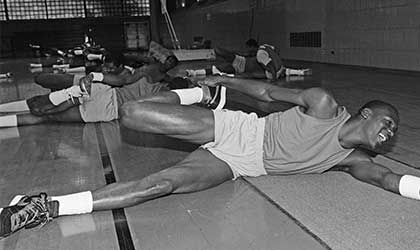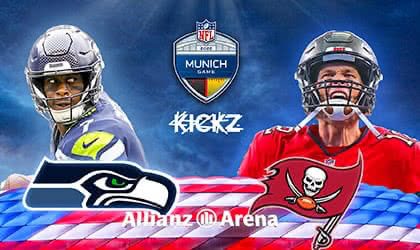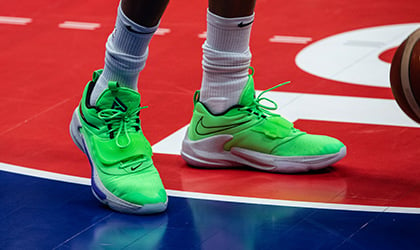The Revolutionary
Von Robbin Barberan
Inhaltsverzeichnis
Dr. Marcus Elliott is the Stephen Hawking of applied sports science. When I wrote an article about sports injury prevention many years ago, this guy's name kept coming up.
Dr. Marcus Elliott is the Stephen Hawking of applied sports science. When I wrote an article about sports injury prevention many years ago, this guy's name kept coming up. Now he was sitting in front of me and I had questions. Dr. Elliott had the answers. And then some…
Interview: Robbin Barberan
FIVE: Dr. Elliott, as the founder and current director of P3 – the most prestigious sports science lab in the world – for our readers who don't know, what is it you guys do exactly?
Dr. Elliott: Well, our mission is to optimize athlete's performance and to predict and prevent injuries through huge amounts of data we collect from said athletes.
This covers all US professional sports?
Yes. I started in the NFL with the Patriots, moved to Major League Baseball with the Mariners and now the NBA.
At first glance three very different kinds of sports. Do they have anything in common?
First off, you have to know that each of these sports is a closed ecosystem. They usually don't communicate a lot with each other or people outside of the sport. It's not easy to get into these environments and I have been very lucky to be able to step into the highest level in one sport and move across to lots of different types of sports. Now, I can tell you that in every sport I go work in there are some dominant paradigms that don't make no sense at all. And because these are closed systems, every team does more or less the same thing and makes the same mistakes. That kind of inefficiency is one commonality.
Are these inefficiencies easy to detect?
Not if you have the right academic background. But there are not a lot of people who work in professional sports who have that.

Which probably leads to stepping on people's toes and telling them things they don't necessarily want to hear…
That's right. It downright pisses people off and I have definitely done that a lot of times. I had to establish early on in my career that I had to be a truth teller above anything else. And if people did not want to hear the truth, well if I'm around they're gonna hear it anyway.
The “if I'm around” part can be dealt with.
Yeah, early on I did not get invited to a lot of cocktail parties or drinks after work. (laughs) Keep in mind that the jobs in the NBA as medical director or director of performance are hard to get. There's 30 of these jobs in the world. Just one per NBA Team. And these people would make a lot less money if they were not in the NBA and with quite a bit less prestige. So these guys really don't want to lose these jobs and they fight to keep them. They work very hard to keep their jobs but not to do their jobs. So, the more right I am, the more pissed off they get. Usually you are hitting a nerve. They know that you are right and you are pointing to some inefficiency. Because they are doing something wrong. Because some injuries are actually their responsibility and not freak injuries or something.
So how do you do things differently at P3?
Personalization is one aspect. No matter in what sport, personalization of training methods will lead to better results and ultimately better performance. Traditionally even at the highest level there is a white board up on the wall of the performance room and there's the workout for the day. It does not matter if your salary is 160 million dollars, all twelve of these players are gonna do the same thing. And that just makes no sense at all. It was just the trainers telling the players what to do instead of gathering data from the players that could lead to optimized workouts. And at P3 we started to change that paradigm. Now everyone does it. Now everyone knows of the importance of athlete data. Now everyone wants personalized programs and injury prevention programs. The things we said 15 years ago, now they believe it. It just took a lot of work to get them there.
The Harvard degree didn't help your credibility?
Not really. In the beginning people thought of me as an overqualified personal trainer. And that was actually one of the things I was most surprised about. I thought the sports world would be more ready to believe the data I was presenting. That's when I learned people's reception to my ideas have much less to do with whether I am right or wrong and more whether or not they made them feel more or less secure. That was a huge disappointment for me. I guess I was just naive and I had to take a stand. It didn't matter to me if everyone in the room disagreed. Now I frequently meet people that tell me that I was their inspiration to get into this field. People who were interested in math and data, yet could make a difference in sports. That is very satisfying for me.
You certainly changed the way NBA teams look at their players both present and future. For example, you and your team have found a way to identify elite perimeter defenders that cuts right through superficial stats like deflections, steals or blocks.
Yes, that's one of the most exciting things we are working on right now. Because a lot of times when players come out of college they are scorers. They have never been asked to do a lot on the defensive side of the ball, because their primary role was to put up 24 points a game. You would have no idea if this guy can defend on an NBA level, because he never had to do it. There was just not good enough data to identify elite defensive players before. On offense the metrics you can gather are decent but on defense they are terrible. We have that reliable data now and that's powerful. Things that go way beyond deflections or how many times you get beat to your left or right. We are able to identify lockdown NBA defenders by looking below the surface, by seeing what nobody else sees. These guys will go in the late 2nd round of the Draft or even go undrafted. Getting a player like that who is overlooked by anybody else could be a pivot point for your organization.
You mentioned looking below the surface and seeing what nobody else sees. So you go beyond what people traditionally considered as being “athletic”…
Exactly. It goes way beyond that. Traditionally 'athletic' means this guy can run fast or that guy can jump high. But there are secondary indicators that come into play here. There is physics behind success in sports. People used to say things like “you can't teach that” or would attribute a lot to “natural talent”, but the reality is the deeper you look the more clear these physics are. I mean, there is a reason why James Harden and Luka Doncic can create space better than others and it's not just that they have a great three point shot. Neither of them is what you normally would call 'athletic' and yet they are able to get their shot off against anyone.
So, how do they do it?
They are the best brakers in the game. They stop better than anyone else. When James Harden was assessed in our facility many years ago he was just average in most ballistic metrics. Not a very fast runner, not a great jumper and so on…, but when we measured his ability to decelerate we saw things we had not seen before in any other player. His stopping ability is off the charts.
Luka has the same ability?
Almost. But the exciting thing about Luka is that we first assessed him when he was just 17. There was this somewhat pudgy white kid from Slovenia who could already do what a Top 5 NBA player could do. It was funny to me that years later when Luka entered the NBA Draft people were debating if he was athletic enough to play in the league. We knew he would turn out to be one of the best players in his class, because we had scientific data of him nobody else had. So the player he turned out to be today, it was not a surprise to us.

If we look at it from the other side, it also means that you don't necessarily have to run fast or jump high to make it in the NBA…
That's one of the biggest fallacies. People think you have to jump particularly high to become a good NBA player. If you look at the data from the NBA combine, there is no correlation between jumping high and having success in the league or having a long career. Zero. That's part of my work I really love. It gives players hope that are not super athletic in the traditional sense but their secondary metrics could be off the charts. Finding these hidden secrets is very exciting and worth a lot of money.
One of the hidden secrets is certainly to predict and to prevent injuries. How predictable are traditional basketball injuries to you?
Many of these injuries, chronic injuries as well as acute injuries, telegraph themselves. The athletes that are really low risk for injuries rarely have those injuries. I look at the data all the time. It's very rare that players that don't have mechanical risk for injury end up developing those injuries. For example we had this one player, Al Jefferson who played center for the Utah Jazz. When we assessed him he was 25 years old and what we saw in his movement pattern was that there was tons of rotation on his right knee, in fact there was no cartilage left in his knee. It was simple physics, sooner or later he was gonna wear out that joint. And we asked ourselves, what if we got this guy when he was 17 and he still had cartilage in his knee. We were still able to prolong his career much longer than it should have been possible but the fact of the matter is the sooner we get a player, the more we can help him. Now young players come and see us before they go to the NBA. Guys like Zion Williamson or R.J. Barrett, these guys all come and spend time with us and get assessed when they are still in high school.
Speaking of high school. The sheer mileage young basketball players put their body through is considerably larger than what it used to be. They start at a younger age, there is that AAU tournament thing… How much of that wear and tear at a younger age is a factor in basketball injuries today?
It's a big problem. And I've been saying it for years. The AAU schedule is super heavy. We did a camp a couple of years ago called “Blueprint” and we had a bunch of the top players in the country. It was a camp where you wouldn't touch a basketball, we were just gonna teach you about your body. You might be 16 or 17 and number 2 kid in your class but nobody is helping you taking care of your body. Nobody is helping you to reduce your risk of injury, nobody is giving you insight of how your body works and all the mechanics involved. So we take three days and teach these kids about caring for themselves. That's not gonna fix the AAU problem in itself but at least the kids know what they are doing to their bodies.

One of the most incredible things I read while preparing for this interview is that you have successfully identified a landing after jumps pattern that increases an NBA player's risk of back injuries by about 300%. That's mind boggling! Could you please talk about that?
Well traditionally if you have back issues, your physical therapist – and it doesn't matter if it's a guy you see around the corner or if it's the guy who is working for an NBA team or the team physician of a European football club – will tell you that you need to work on your core strength. I can tell you that you might have amazing core strength, but if you land wrong the shear forces you have to endure across your back are too big for whatever core strength you have to withstand. It's a simple movement pattern and we can divide about two thirds of our athletes that land safely and one third lands the wrong way. And it's the same way for new players that come in from the NBA combine or are proven league veterans. We have done this year after year and it's almost always the same. A third of them land the wrong way and increase their risk to back injury by 300%. So instead of just improving your core strength, which we have traditionally done in sports medicine, you should probably work on your landing.
This is a huge thing and the next question that comes to mind is whether you only teach the proper way to land to the player that is standing right infront of you or do you put any effort in getting word out to the whole league?
Our approach at P3 is that we have an open door policy. A lot of people question it but we let almost anybody in, we try to practice full transparency. So if an NBA strength coach or an NBA medical director wants to come in he is free to come and we show him everything. We want to do anything we can to support the player, no matter if that means telling his team strength coach, no matter if that means telling his college coach or whoever trains him in the offseason. Whoever the player trusts and is part of his inner circle, we share that information with.
That's a commendable approach…
(shrugs) Well, we try to raise the bar in sports and we do have the most information and data, so the more the bar is raised, the more people are thinking the same, the more cause and effect, the more … (smiles) powerful our position.
We just talked about wear and tear. What's your opinion on 'Load Management'?
I think Load Management … (hesitates)… I think it's kinda stupid. It's what you do when you don't know what to do. If you don't know better, it's just like 'okay let's just reduce the risk by playing less'. If you worry about players getting hurt and you don't know any detail about why they might get hurt or how to remove anything specifically you just say 'well, let's not just do very much of that.' They do the same thing in baseball. They limit the pitch count of a pitcher when the reality is that some guys throw balls and the way they throw they will be able to throw years and years and nothing's gonna get broken. Same thing with NBA players. The truth is that two players that land very different ways but have the same load can withstand very different amounts of loads. You don't need to look at the magnitude and frequency of the loads applied to an athlete but you have to understand how that load is internalized to understand the risk. And every player is different. The idea that you're gonna put caps on all these players makes no sense. And I think there's gonna be a big pushback against Load Management sooner rather than later.
In your line of work you also studied the evolution of sports and its athletes. How different are today's athletes from guys who played in the 1970s or 80s?
(laughs) You know, it's interesting because right now the comparisons between Michael Jordan and LeBron James come up more and more now that he has won his fourth championship. And people either forget or they don't know that athletes that are in the NBA right now are so much better than at the time when MJ was playing…
… so much better physically. We are not talking about actual basketball skills.
Yes, we are talking about physical systems. Physical systems are easy for us to compare. In the last ten years alone physical systems have changed a ton. And that's just ten years. If you go back another ten years it is lightyears away. Lightyears! These guys are so different athletes than what they were 20 years ago. So this “Greatest Player of All Time” discussion – and I kinda sense that you're an MJ guy – is funny to me. If he was playing today he would not be the best player in the league. Even at his peak, he'd be good right now but not the best. Not even close. He just doesn't have the physical system to compete with NBA athletes of 2020. That's just the truth and I don't understand how that is not factored in.
As basketball keeps getting faster and more athletic and puts more strain on athletes' bodies, isn't it inevitable that some day we reach the absolute limit of what the human body can take?
I think people have been saying that for a long time. (laughs) All these sports keep moving forward, all of them. The incentives are so high. NBA players are not even close to being optimized. They can all be better physically. It's gonna get faster. It's gonna get more ballistic. The NBA of 2025 is not gonna be slower than today. There will be even better athletes. The average NBA team, they now have bigger staffs than ever before, but they are not efficient yet. They are mediocre in taking care of their players. So… where does it end? It's gonna get faster and it's gonna get better.
Thank you for your time, Dr. Elliott. By the way, yes, I am an MJ guy. But not the one that played for the Bulls.
—
by FIVE Magazine #173 – Interview with Dr. Marcus Elliott – Text: Robbin Barberan

Inhaltsverzeichnis
Empfohlene Artikel

DIE GESCHICHTE DES NIKE AIR SHIP

KICKZ Performance Review: Nike PG 6


